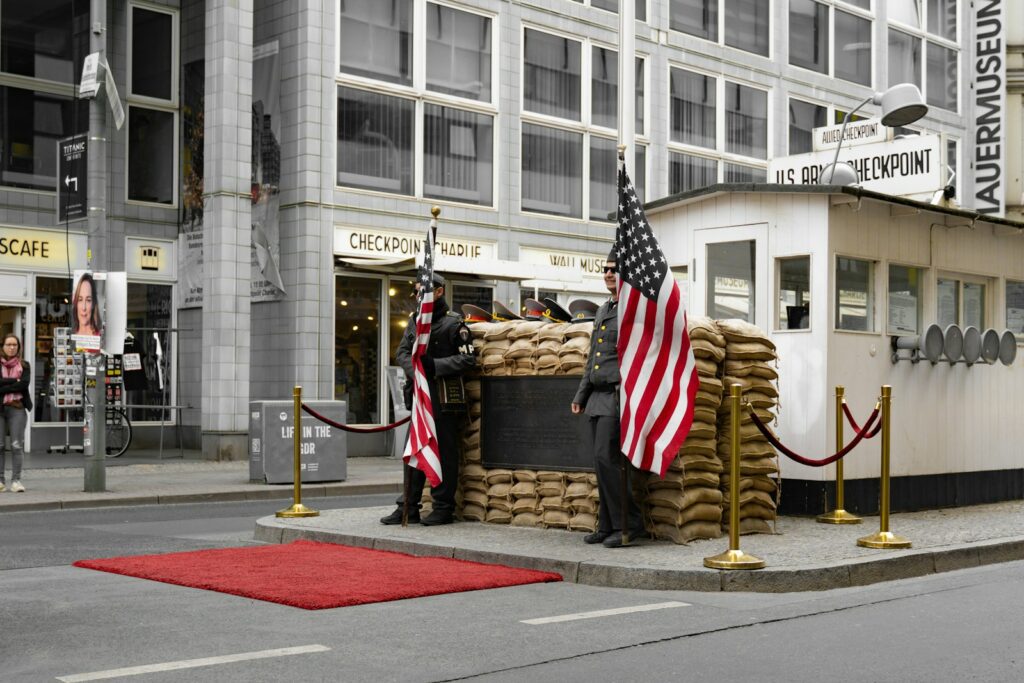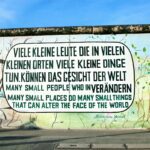Checkpoint Charlie, one of the most iconic symbols of the Cold War, stands as a testament to Berlin’s turbulent history. This former border crossing between East and West Berlin offers a poignant reminder of the division that once split Germany and the world into two ideological camps. Today, it serves not only as a historical landmark but also as a popular tourist destination where visitors can learn about the struggles and stories of those who lived during that era.
The Historical Significance of Checkpoint Charlie
The Origins and Purpose of Checkpoint Charlie
Established in 1961, Checkpoint Charlie was one of the few crossing points along the Berlin Wall. Its primary purpose was to regulate the movement of Allied forces and non-German citizens between the Soviet-controlled East Berlin and the Allied-occupied West Berlin. The name “Charlie” comes from the NATO phonetic alphabet, where “C” stands for Charlie, following Checkpoints Alpha and Bravo.
The Berlin Wall and the Cold War Context
To fully appreciate Checkpoint Charlie, one must understand the broader context of the Berlin Wall and the Cold War. Post-World War II, Germany was divided into four occupation zones controlled by the United States, the United Kingdom, France, and the Soviet Union. Tensions between the Soviet Union and the Western Allies led to the creation of two separate German states in 1949: the Federal Republic of Germany (West Germany) and the German Democratic Republic (East Germany).
In 1961, East Germany erected the Berlin Wall to prevent the mass exodus of its citizens to the West. Checkpoint Charlie quickly became a focal point for the struggle between East and West, symbolizing the ideological divide.
Dramatic Escapes and Standoffs
Checkpoint Charlie was the site of numerous escape attempts, some successful and others tragically fatal. These daring acts highlighted the desperation and determination of East Berliners seeking freedom. One of the most famous incidents was the standoff between American and Soviet tanks in October 1961, a moment when the world teetered on the brink of nuclear war.
Visiting Checkpoint Charlie Today
Location and Accessibility
Located at the intersection of Friedrichstraße and Zimmerstraße, Checkpoint Charlie is easily accessible by public transport, including the U-Bahn (subway). Its central location makes it a convenient stop for tourists exploring Berlin’s many historical sites.
The Checkpoint Charlie Museum
The Checkpoint Charlie Museum, also known as the Mauermuseum, was established in 1962, just a year after the checkpoint was created. The museum offers an extensive collection of artifacts, photographs, and personal stories related to the Berlin Wall and the Cold War. Visitors can see the inventive methods used by East Berliners to escape, such as hidden compartments in cars and homemade hot air balloons.
Reconstructed Guardhouse and Touristic Attractions
At the site of the original checkpoint, a reconstructed guardhouse stands as a reminder of its historical significance. Actors dressed as Allied soldiers pose for photos with tourists, adding a touch of living history to the experience. Nearby, informative panels provide context and background about the checkpoint and its role during the Cold War.
Checkpoint Charlie in Popular Culture
Depictions in Movies and Literature
Checkpoint Charlie has been immortalized in various films, books, and TV shows, cementing its place in popular culture. Notable appearances include the spy thriller “The Spy Who Came in from the Cold” and Steven Spielberg’s “Bridge of Spies.” These works capture the tension and intrigue of the Cold War era, often featuring scenes at this iconic crossing point.
Checkpoint Charlie as a Symbol of Freedom
Beyond its historical and cultural significance, Checkpoint Charlie symbolizes the quest for freedom and the resilience of the human spirit. It represents the triumph of hope over oppression and the eventual fall of the Berlin Wall in 1989, leading to German reunification.
Practical Tips for Visitors
Best Time to Visit
To avoid crowds, consider visiting Checkpoint Charlie early in the morning or later in the afternoon. Weekdays tend to be less crowded than weekends, providing a more relaxed experience.
Guided Tours and Educational Programs
For a deeper understanding of Checkpoint Charlie’s history, consider joining a guided tour. Many tours are available, offering insights from knowledgeable guides who can share personal anecdotes and detailed historical context. Educational programs for school groups and other organizations are also available through the museum.
Nearby Attractions
Checkpoint Charlie is situated in a vibrant area of Berlin, with several other historical and cultural attractions nearby. The Topography of Terror, a documentation center on Nazi crimes, and the Jewish Museum Berlin are both within walking distance. Additionally, visitors can explore the remnants of the Berlin Wall at the East Side Gallery, a short drive or train ride away.
FAQs
Why is Checkpoint Charlie famous? Checkpoint Charlie is famous as a symbol of the Cold War and the Berlin Wall, representing the division between East and West Berlin. It was a key crossing point for Allied forces and a site of dramatic escapes and standoffs.
Can you still see the original Checkpoint Charlie? The original guardhouse was removed, but a replica now stands at the site, along with informative panels and exhibits. The Checkpoint Charlie Museum nearby houses many original artifacts and documents.
What is the Checkpoint Charlie Museum? The Checkpoint Charlie Museum, or Mauermuseum, is dedicated to the history of the Berlin Wall and the Cold War. It features exhibits on escape attempts, personal stories, and the broader context of the division of Berlin.
How do I get to Checkpoint Charlie? Checkpoint Charlie is located at the intersection of Friedrichstraße and Zimmerstraße in Berlin. It is easily accessible by public transport, including the U-Bahn (subway).
What are some nearby attractions? Nearby attractions include the Topography of Terror documentation center, the Jewish Museum Berlin, and the East Side Gallery, which features murals on the remnants of the Berlin Wall.
When is the best time to visit Checkpoint Charlie? To avoid crowds, it’s best to visit early in the morning or later in the afternoon, particularly on weekdays.
Conclusion
Checkpoint Charlie remains a powerful reminder of Berlin’s divided past and the broader Cold War conflict. Visiting this historic site offers a unique opportunity to reflect on the struggles and triumphs of those who lived through that era. Whether you’re a history buff or a casual tourist, Checkpoint Charlie provides a poignant and educational experience that underscores the enduring quest for freedom and unity.



